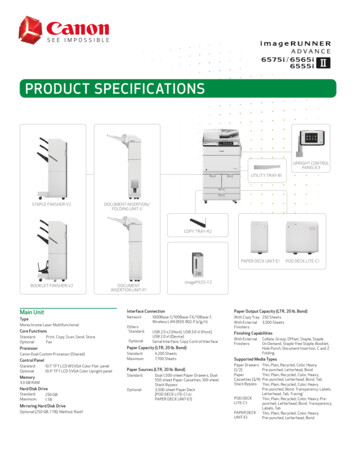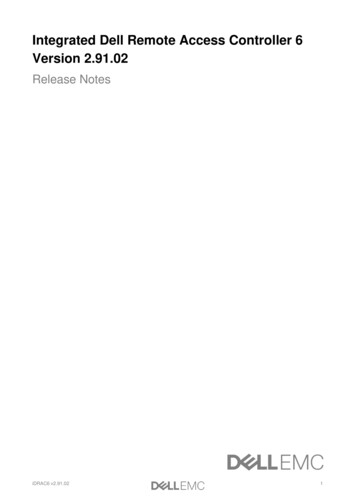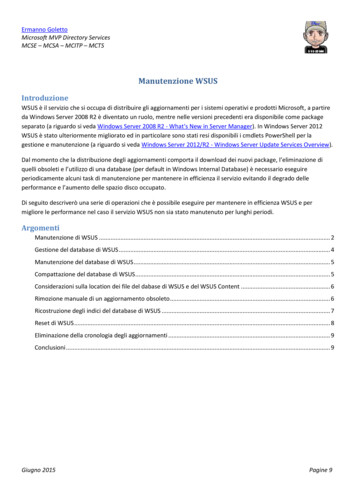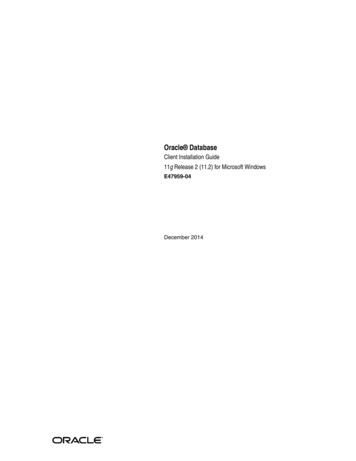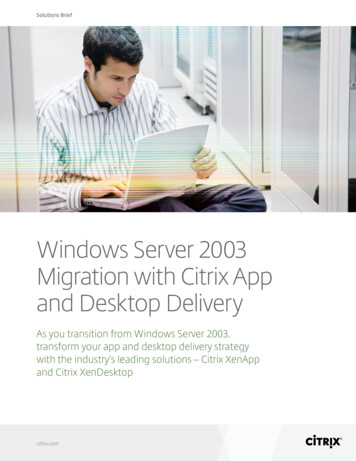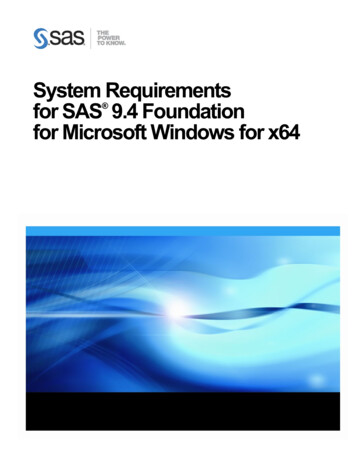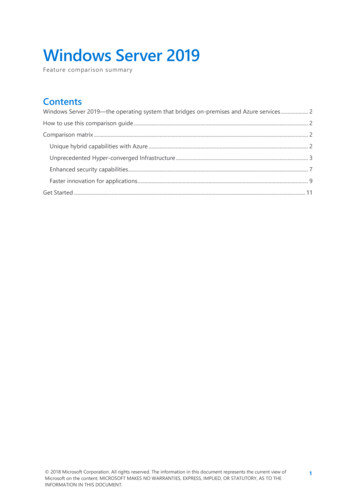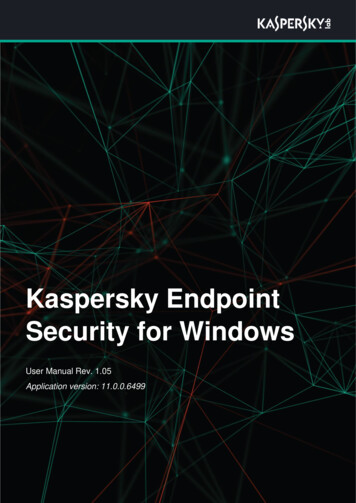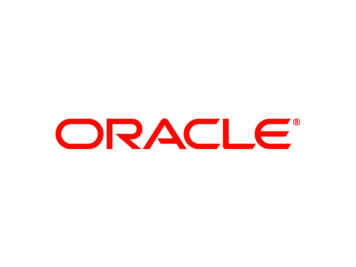
Transcription
Administering Windows Server 2012Length: 5 DaysAbout this Course: Get hands-on instruction and practice administering Windows Server 2012, including Windows Server 2012 R2, inthis five-day course. This course is part two in a series of three courses that provides the skills and knowledge necessary to implement acore Windows Server 2012 infrastructure in an existing enterprise environment.The three courses collectively cover implementing, managing, maintaining and provisioning services and infrastructure in a WindowsServer 2012 environment. Although there is some cross-over of skills and tasks across these courses, this course focuses on theadministration tasks necessary to maintain a Windows Server 2012 infrastructure such as configuring and troubleshooting nameresolution, user and group management with Active Directory Domain Services (AD DS) and Group Policy, implementing Remote Accesssolutions such as DirectAccess, VPNs and Web Application Proxy, implementing Network Policies and Network Access Protection, DataSecurity, deployment and maintenance of server images, as well as update management and monitoring of Windows Server 2012environments.This course maps directly to and is the preferred choice for hands-on preparation for Microsoft Certified Solutions Associate (MCSA):Exam 411: Administering Windows Server 2012, which is the second of three exams required for MCSA: Windows Server 2012 credential.Audience Profile: This course is intended for Information Technology (IT) Professionals with hands on experience working in a Windowsserver 2008 or Windows Server 2012 environment who wish to acquire the skills and knowledge necessary to be able to manage andmaintain the core infrastructure required for a Windows Server 2012 and Windows Server 2012 R2 environment. The key focus forstudents is to broaden the initial deployment of Windows Server 2012 services and infrastructure and provide the skills necessary toManage and Maintain a domain based Windows Server 2012 environment, providing skills in areas such as User and Group management,Network Access and Data Security. Candidates typically interested in attending this course would be: Windows Server Administrators experienced in working with Windows Server 2008 or Windows Server 2012 who wish to gainskills necessary to perform daily management and maintenance tasks in a Windows Server 2012 or Windows Server 2012 R2environment. IT Professionals who are looking to take the 411, Administering Windows Server 2012 exam IT professional wishing to take the Microsoft Certified Solutions Expert (MCSE) exams in DataCenter, Desktop Infrastructure,Messaging, Collaboration and Communications will also be interested in taking this course as they prepare for the MicrosoftCertified Solutions Associate (MCSA) exams, which are a pre-requisite for their individual specialties.At Course Completion: After completing this course, students will be able to: Configure and Troubleshoot Domain Name System Implement Remote Access Maintain Active Directory Domain Services Optimize File Services Manage User and Service Accounts Configure Encryption and Advanced Auditing Implement Group Policy Infrastructure Deploy and Maintain Server Images Manage User Desktops using Group Policy Implement Update Managements Install, Configure and Troubleshoot Network Policy Server Monitor Windows Server 2012 Implement Network Access ProtectionLearnsoft Enterprise Training4350 Executive Drive Ste. 100 l San Diego, CA 92121 Office: 858.546.1400 l Fax: 858.546.1791
COURSE CONTENT Implementing Virtualized DomainModule 1: Configuring and TroubleshootingControllersDomain Name System Implementing RODCsThis module explains how to configure and Administering AD DStroubleshoot DNS, including DNS replication and Managing the AD DS Databasecaching.Lab : Maintaining AD DSLessons Configuring the DNS Server Role Configuring DNS Zones Configuring DNS Zone Transfers Managing and Troubleshooting DNS Installing and Configuring a RODC Configuring AD DS Snapshots Configuring the Active Directory Recycle Bin Optional Exercise- Cloning a domaincontrollerLab : Configuring and Troubleshooting DNS Configuring DNS Resource Records Configuring DNS Conditional Forwarding Installing and Configuring DNS Zones Troubleshooting DNSAfter completing this module, students will be able to: Install and configure the DNS server role.After completing this module, students will be able to: Implement virtualized domain controllers. Implement RODCs. Administer AD DS. Manage the AD DS databaseModule 3: Managing User and Service Accounts Create and configure DNS zones.This module explains how to create, configure and Configure DNS zone transfers.automate the creation of user accounts. It also Manage and troubleshoot DNS.of user objects. It further explains how to create andModule 2: Maintaining Active Directory DomainServicesThis module explains how to implement virtualizeddomain controllers and read-only domain controller(RODCs). It also explains how to perform common ADexplains how to configure account-related propertiesadminister Managed Service Accounts.Lessons Configuring Password Policy and UserAccount Lockout Settings Configuring Managed Service AccountsDS administrative tasks and manage the AD DSLab : Managing User and Service AccountsDatabase.Lessons Configuring Password Policy and Account Overview of AD DSLockout SettingsLearnsoft Enterprise Training4350 Executive Drive Ste. 100 l San Diego, CA 92121 Office: 858.546.1400 l Fax: 858.546.1791
Creating and Associating a ManagedService AccountAfter completing this module, students will be able to: Configure password policy and user accountlockout settings. Configure managed service accounts.Module 5: Managing User Desktops with GroupPolicyThis module explains how you can use Group PolicyObjects (GPOs) to implement desktop environmentsacross your organization by using AdministrativeTemplates, Folder Redirection, Group Policypreferences, and where applicable, use softwareModule 4: Implementing a Group Policydeployment to install and update applicationInfrastructureprograms. It is important to know how to use theseThis module explains how to implement a GPOinfrastructure. This also teaches how to performcommon GPO management tasks, and managevarious GPO features so that you can configure yourusers’ computer settings properly.LessonsGPOs by using Windows PowerShell. It also focuses Implementing Administrative Templateson troubleshooting the application of GPOs. Configuring Folder Redirection and ScriptsLessons Configuring Group Policy Preferences Introducing Group Policy Implementing and Administering GPOs Group Policy Scope and Group PolicyProcessing Troubleshooting the Application of GPOs Managing Software with Group PolicyLab : Managing User Desktops with Group Policy Implement Settings by Using Group PolicyPreferences Managing Office 2013 by usingLab : Implementing a Group Policy Infrastructure Creating and Configuring Group PolicyObjects Managing GPO Scope Verify GPO Application Managing GPOsAfter completing this module, students will be able to: Explain what Group Policy is. Implement and administer Group PolicyObjects (GPOs). Manage Group Policy scope and GroupPolicy processing. Troubleshoot the application of GPOs.Administrative Templates Deploying Software by using Group Policy Configuring Folder RedirectionAfter completing this module, students will be able to: Configure folder redirection and scripts byusing GPOs. Describe and implement AdministrativeTemplates. Configure GPO preferences. Deploy software by using GPOs.Module 6: Installing, Configuring, andTroubleshooting the Network Policy Server RoleThis module explains how to install and configureNPS, RADIUS Clients and servers. It also describesNPS authentication methods. It describe NPSauthentication methods and how to
monitor and troubleshoot NPS. Configuring Virtual Private Network AccessLessons Configuring the Client Settings to Support Installing and Configuring a Network PolicyServer Configuring RADIUS Clients and ServersNAPAfter completing this module, students will be able to: Describe how NAP can help to protect yournetwork. NPS Authentication Methods Monitoring and Troubleshooting a NetworkPolicy ServerLab : Installing and Configuring a Network PolicyServer Installing and Configuring NPS to SupportRADIUS Configuring and Testing a RADIUS ClientAfter completing this module, students will be able to: Install and configure a Network PolicyServer (NPS). Configure clients and servers with theRemote Authentication Dial-In UserService (RADIUS) protocol. Explain NPS authentication methods. Monitor and troubleshoot NPS.Module 7: Implementing Network AccessProtectionThis module explains how to configure, monitor, andtroubleshoot NAP. It also explains how NAP can helpto protect your network and the various NAPenforcement processes.Lessons Overview of Network Access Protection Overview of NAP Enforcement Processes Configuring NAP Configuring IPSec Enforcement for NAP Monitoring and Troubleshooting NAPLab : Implementing Network Access Protection Configuring NAP Components Describe the various NAP enforcementprocesses. Configure NAP. Monitor and troubleshoot NAP.Module 8: Implementing Remote AccessIn this module, you will learn how to implement andmanage remote access in Windows Server 2012. Youwill also learn how to implement DirectAccess byusing the Getting Started wizard, implement andmanage an advanced DirectAccess infrastructure,and implement VPN.Lessons Overview of Remote Access Implementing DirectAccess by Using theGetting Started Wizard Implementing and Managing an AdvancedDirectAccess Infrastructure Implementing VPN Implementing Web Application ProxyLab : Implementing DirectAccess by Using theGetting Started Wizard Verifying Readiness for a DirectAccessDeployment Configuring DirectAccess Validating the DirectAccess DeploymentLab : Deploying an Advanced DirectAccessSolution Preparing the Environment for DirectAccess Implementing the Advanced DirectAccessInfrastructure Validating the DirectAccess Deployment
Lab : Implementing VPN Implementing VPN Validating the VPN DeploymentLab : Configuring Quotas and File ScreeningUsing File Server Resource Manager Configuring File Server ResourceManager Quotas Configuring File Screening and StorageReportsLab : Implementing Web Application Proxy Implementing Web Application Proxy Validating the Web Application ProxyDeploymentAfter completing this module, students will be able to: Install and manage the Remote Access rolein Windows Server 2012 operating system.Lab : Implementing Distributed File System Installing the DFS role service Configuring a DFS Namespace Configuring DFS ReplicationAfter completing this module, students will be able to: Describe the File Server Resource Manager(FSRM) in the Windows Server 2012 Implement DirectAccess by using theoperating system.Getting Started Wizard. Implement and manage an advanced Use FSRM to manage quotas, file screens,and storage reports.DirectAccess Infrastructure. Implement VPN access. Implement classification and filemanagement tasks. Implement Web Application Proxy. Describe Distributed File System (DFS).Module 9: Optimizing File ServicesThis module describes FSRM, configure quotas, filescreening, and storage reports and implement Configure DFS namespaces. Configure and troubleshoot DFSclassification management and file managementtasks. It describes the components of the DFS. I alsoexplains how to configure DFS namespaces and DFSReplication.Module 10: Configuring Encryption and Advancedreplication.AuditingLessonsThis module explains how to encrypt files using EFS Overview of FSRM Using FSRM to Manage Quotas, FileScreens, and Storage Reports Implementing Classification and FileManagement Tasksand configure advanced auditing features.Lessons Encrypting Drives by Using BitLocker Encrypting Files by Using EFS Configuring Advanced Auditing Overview of DFS Configuring DFS Namespaces Configuring and Troubleshooting DFSReplicationLab : Configuring Encryption and AdvancedAuditing Using Windows BitLocker Drive Encryptionto Secure Data Drives
Encrypting and Recovering Files Configure Windows Deployment Services in Configuring Advanced AuditingAfter completing this module, students will be able to: Secure data by using BitLocker DriveWindows Server 2012. Perform deployments with WindowsDeployment Services.Encryption. Encrypt files by using Encrypting FileSystem (EFS). Configure advanced auditing.Module 11: Deploying and Maintaining ServerModule 12: Implementing Update ManagementThis module explains how to use Windows ServerUpdate Services (WSUS) to deploy updates toWindows servers and clients.LessonsImages Overview of WSUSThis module explains how to create and manage Deploying Updates with WSUSserver images by using Windows DeploymentLab : Implementing Update ManagementServicesLessons Implementing the WSUS Server Role Overview of Windows Deployment Services Managing Images Implementing Deployment with WindowsDeployment Services Administering Windows Deployment Configuring Update Settings Approving and Deploying an Update byusing WSUSAfter completing this module, students will be able to: Describe the role of WSUS.ServicesLab : Using Windows Deployment Services toDeploy Windows Server 2012 Installing and Configuring WindowsDeployment Services Creating Operating System Images withWindows Deployment Services Describe the WSUS updatemanagement process. Deploy updates with WSUS.Module 13: Monitoring Windows Server 2012This module explains the monitoring tools available inWindows Server 2012. it also explains how to use Configuring Custom Computer NamingPerformance Monitor and monitor events. Deploying Images with WindowsLessonsDeployment ServicesAfter completing this module, students will be able to: Describe the important features and Monitoring Tools Using Performance Monitor Monitoring Event Logsfunctionality of Windows DeploymentServices (Windows DS). Manage images by using WindowsAssessment and Deployment Kit(Windows ADK) Tools.Lab : Monitoring Windows Server 2012 Establishing a Performance Baseline Identifying the Source of a PerformanceProblem
Viewing and Configuring Centralized EventLogsAfter completing this module, students will be able to: Describe the monitoring tools for theWindows Server 2012 operating system. Use Performance Monitor to view andanalyze performance statistics of programsthat are running on their servers. Monitor event logs to view and interpret therecorded events.
Exam 411: Administering Windows Server 2012, which is the second of three exams required for MCSA: Windows Server 2012 credential. Audience Profile: . Professionals with hands on experience working in a Windows server 2008 or Windows Server 2012 environment who wish to acquire the skills and knowledge necessary to be able to manage and
